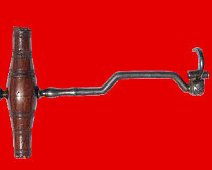
The dental key is an instrument that was used in dentistry to extract diseased teeth. Before the era of antibiotics, dental extraction was often the method of choice to treat dental infections, and extraction instruments date back several centuries. The dental key was first mentioned in Alexander Monro‘s Medical Essays and Observations in 1742, but had probably been in use since around 1730. It remained popular into the 20th century when it was replaced by the more modern forceps.
Modeled after a door key, the dental key was used by first inserting the instrument horizontally into the mouth, then its “claw” would be tightened over a tooth. The instrument was rotated to loosen the tooth. This often resulted in the tooth breaking, causing jaw fractures and soft tissue damage.
This particular key made by the English maker Francis Cluley. According to Elisabeth Bennion, Francis Cluley began working in Sheffield in 1813 and no trace of him can be found after 1837. This latter date would seem to be borne out by the discovery of the October 30, 1841 edition of the South Yorkshire newspaper, “Sheffield Independent”, which mentions the last will of “the late Mr. Cluley, of Sheffield, Surgical Instrument Maker.” Alex Peck of the website antiquescientifica.com refers to Cluley as “a relatively rare Georgian surgical instrument maker.”
